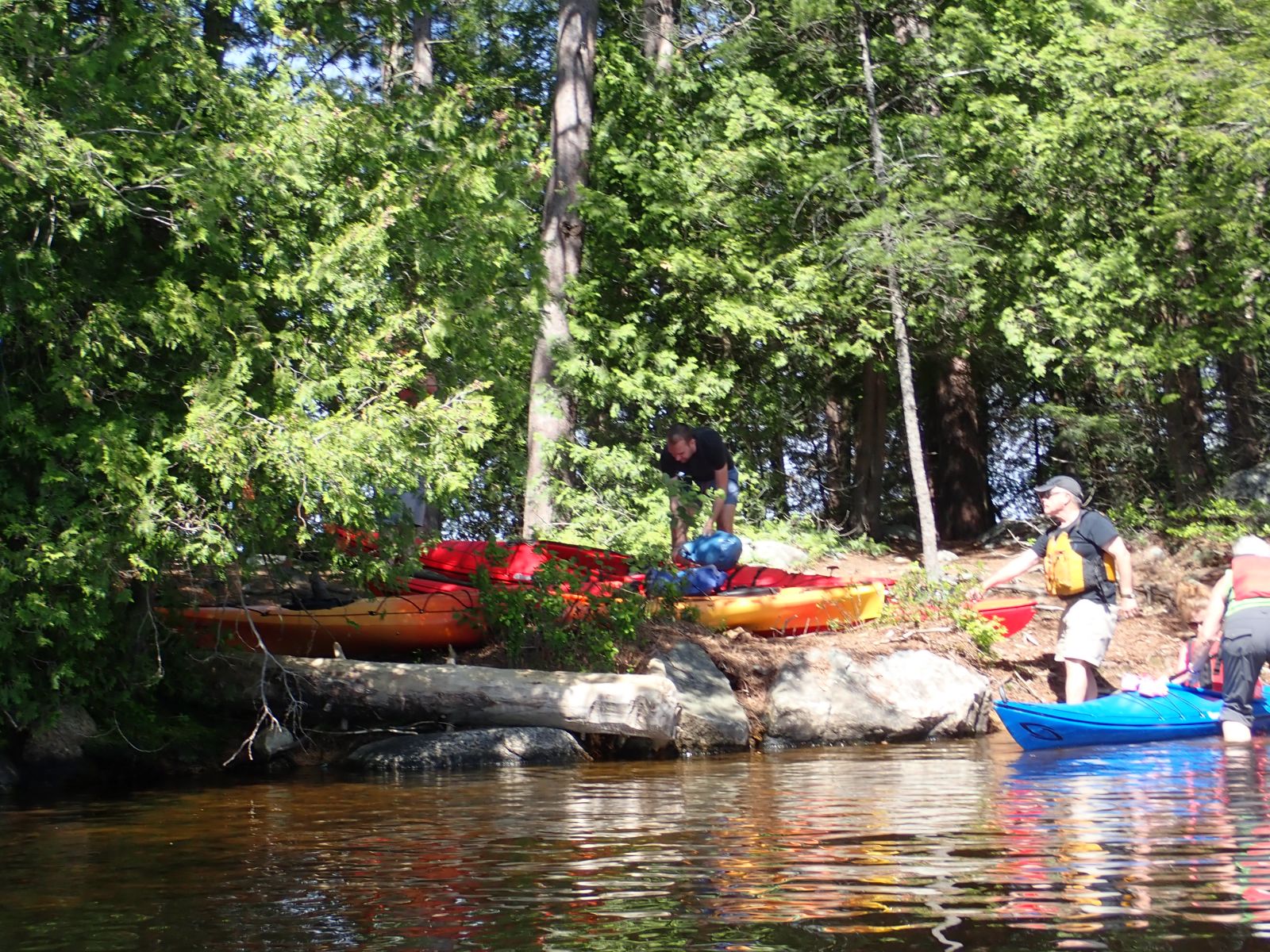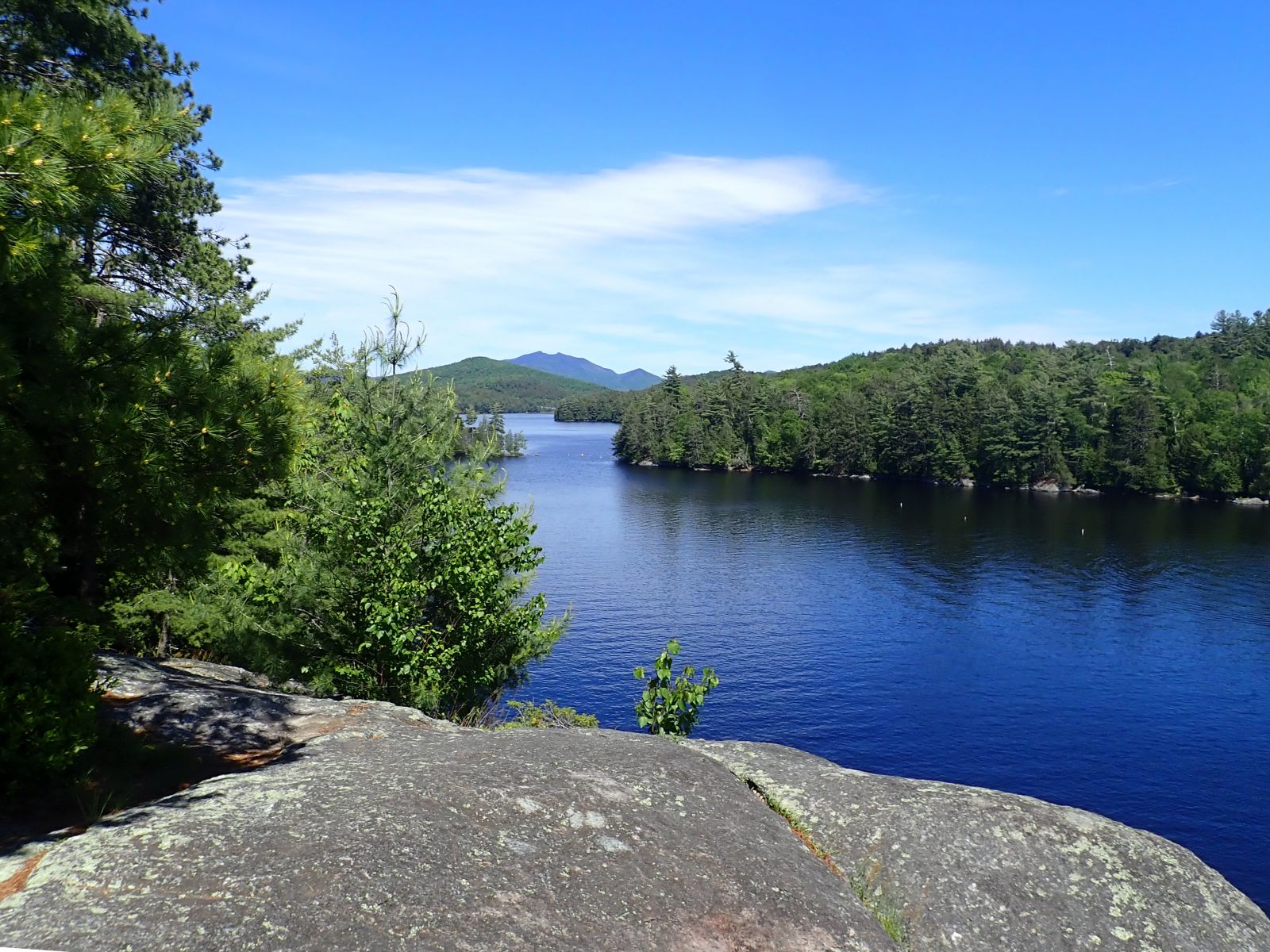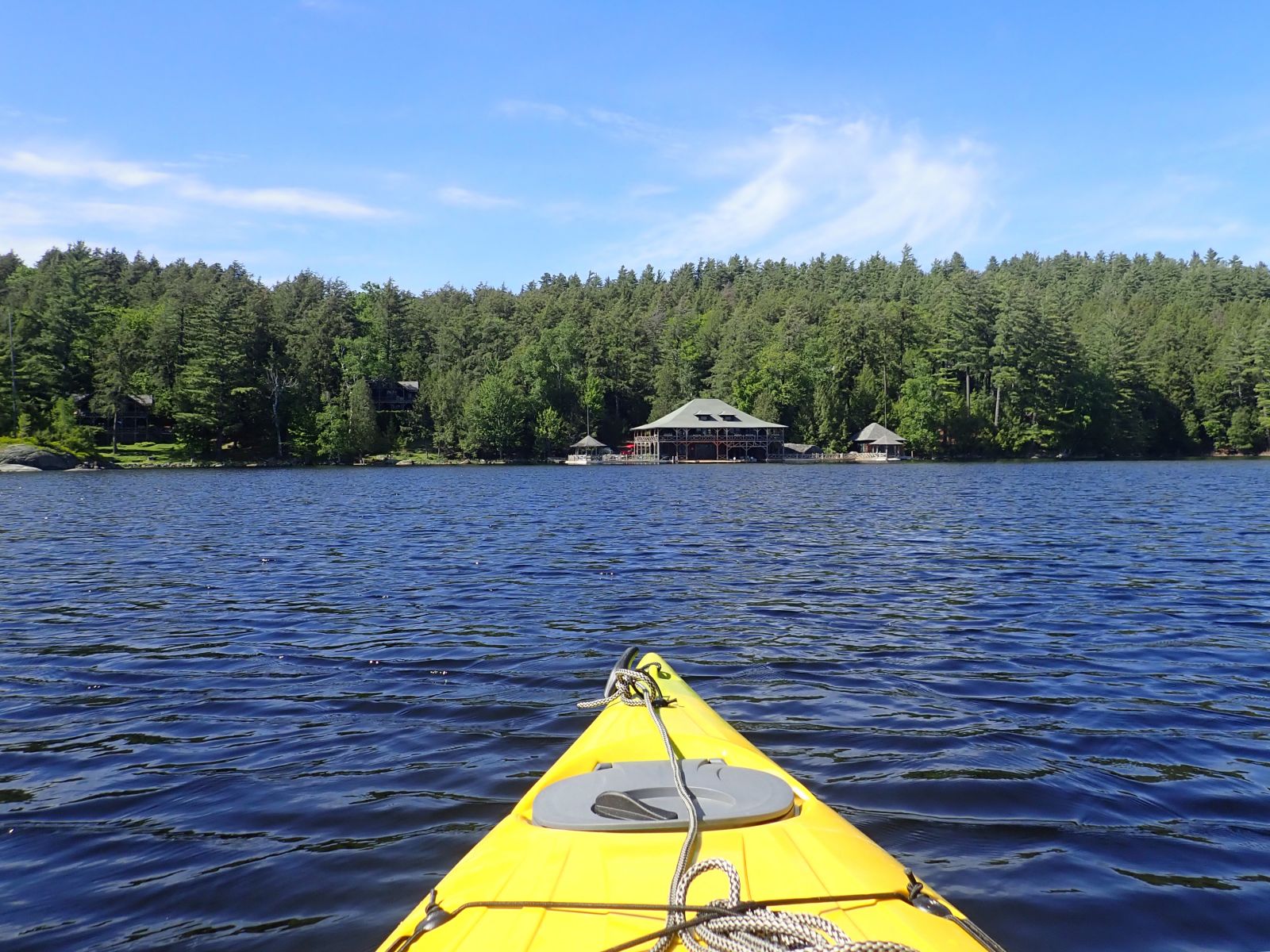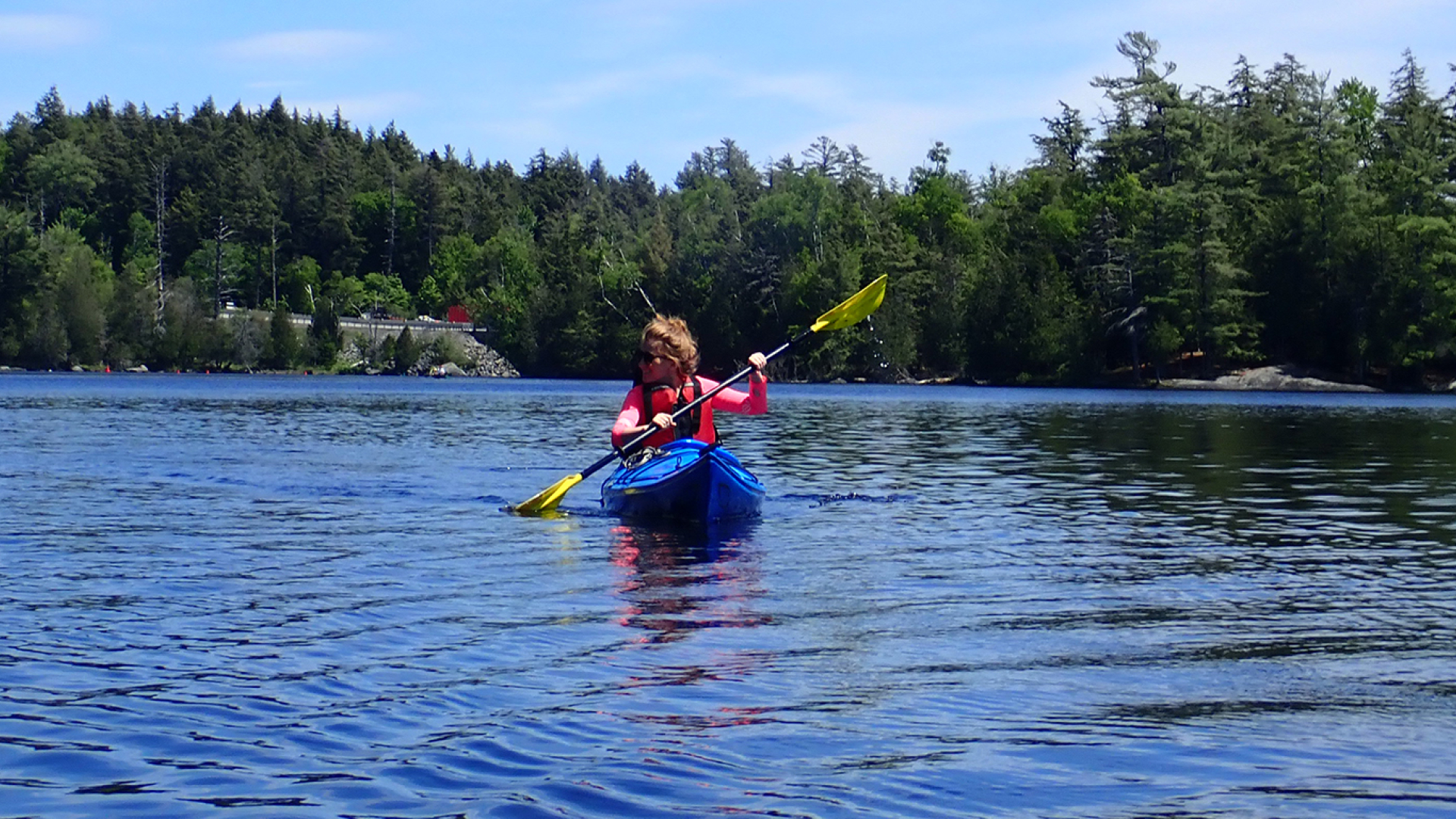Sumitted by guest writer Rivka Cilley
Our dog Raquette starts getting excited the moment we take out our paddles. He knows that he is in for a long day of relaxing on the water. We are expecting an easy day on the water with plenty of sunshine and fresh air. The paddle from State Bridge to Ampersand Bay on Lower Saranac Lake is a great trip for kayaking on open water in a scenic, island studded lake. The trip is close to downtown Saranac Lake. It’s only 4 miles to what locals refer to as State Bridge (Saranac Islands Public Campground) our put in spot. It is a busy parking lot, but there is usually ample parking available.
As we unload our boats, paddles and life jackets on this gorgeous, warm, sunny day in July we check to make sure we have everything. We packed a picnic lunch. We also have plenty of fresh drinking water, a pair of sneakers for hiking up to the top of the bluff on Bluff Island, our handy emergency kit, and a jacket that we can use as a wind or rain jacket in the event of inclement weather. My years growing up in girl scouts always taught me to be prepared for anything. We are wearing our bathing suits and a sturdy pair of Chaco sandals.

We slather our bodies with sunscreen, fasten our PFDs and excitedly jump into our kayaks. We launch our kayaks from the sandy beach designated for paddlers and head west. As we paddle under the bridge and enter First Pond, the sounds of the highway quickly disappear. We stop to examine the plants along the shore and spot a lily-looking plant, a Clintonia with the greenish white berries that will soon turn into a dark blue. It’s commonly called the Blue bead lily after the berry. Next to it we spot a Gold thread—it looks like a glossy Cilantro leaf with three lobes. Gently, we pull back the surrounding moss and peek in to find its namesake, the bright orange or gold colored roots. We are careful to tuck everything back so no one even knows we’ve been snooping around underground. Getting back in our boats we hear a gentle puff of wind blowing through the white pine trees along the shore.
As we come to the channel of Lower Saranac Lake we are struck by the awesome view. To the north, west and south of us are clusters of islands, all part of the state campground, most of which have designated campsites on them. To the north east we take in the view of the McKenzie Mountain Wilderness area with McKenzie (3,822 feet), Haystack (2,878 feet), Dewey (2,050 feet) and Baker Mountain (2457 feet) rising in the distance. Baker, McKenzie and Haystack are three of the six mountains in the “Saranac Lake 6ers” that we love to hike.
We stop on Bluff Island, a nine acre island with a seventy-foot cliff that rises straight up from the water. The Point on the southwest side of the island has a day use only site with a picnic table set up. It also is a nice place to swim with easy access in and out of the water. We pull our kayaks up on the land and set off to hike up to the bluff. Our dog, Raquette, is happy to be on the island where he can run and play with us. Of course, he is a constrained by our ability to keep up and we are out of breath before he is. Fortunately, the hike is a short scramble up a well tread trail. Once up on the bluff we stop to take in the view of the area. We can see a long distance up and down the lake. We enjoy watching people ply the lake and negotiate the entrance to the Saranac River.

From the 1930’s to the 1970’s Lower & Middle Saranac Lake campsites were set up for long term lease with tent platforms. Families would lease the site allowing them to spend their summers on the islands. Joe Harley, an engineer at Bell Labs, and his wife Mary leased a site on one end of Bluff Island. The Jaffe family leased a tent platform site on the other end of the island. In 1971 the state repealed the tent platform permits opening the islands up for more people to camp and enjoy the islands. There is now no trace of those old tent platforms on Bluff Island. Moss, shrubs and trees cover most of the island.
Today the Saranac Lake Islands Campground covers most of the lake, both islands and shoreline. We see lots of people enjoying the area. As we paddle away from the Bluff, we pass Pirate Island, Burnt Island, Halfway Island, Otter Island and Fern Island. Seagulls soar through the blue sky savoring the gentle breeze. We hear a loon calling in the distance. Most of the campsites are occupied. The smell of barbeque and cooking food wafts out over the water. Children jump in the water and a few fishermen are looking hopeful and serious. They are all enjoying themselves and the beauty of this place.
It is easy to imagine back in time when the Mohawks and Algonquins inhabited these same islands –with people fishing, cooking and swimming. It is believed that the Algonquins hunted and fished in the Adirondacks starting around 10,000 BC. According to an article by J. Dyneley, “Some Forgotten Indian Place-Names in the Adirondacks,” published in the Journal of American Folklore, Vol. 13, No. 49 (Apr. - Jun., 1900), pp. 123-128, the name Saranac is believed to be derived from a genuine Abenaki Indian word meaning “entrance to a river” in reference to the outlet of the Saranac River in Plattsburgh. The author based this information in part on an interview with Mitchell Sabattis (1823-1906), an Abenaki Indian and famous Adirondack Guide.

We stop at an empty site with a bare rocky landing on one of the Three Sisters Island to take a break and hang out. There is an eagle’s nest on one of the islands and the eagle is visible with binoculars. We sit and watch the eagle as we soak in the sunshine. Nearby Eagle Island is the largest island on Lower Saranac Lake with several spectacular campsites. There is a plaque mounted on a rock on the eastern side of the island entitled Tom’s Rock. A lean-to with the plaque were built in memory of Tom Rosenberg, a boy who spent a lot of time on Eagle Island, which he cherished in spite of his poor health.
From Three Sisters Island we can see Knollwood to the west. Knollwood Club Great Camp is still owned and inhabited by one of the original families who built the camp @ 1900. A group of six friends built the camp including: Louis Marshall, Daniel Guggenheim, George Blumenthal, Elias Asiel, Max Nathan, and A.N. Stein. They chose to build on Lower Saranac Lake in reaction to the anti-Semitism they experienced in other places. Louis Marshall’s sons-- Bob and George grew up spending their summers at this camp. Bob Marshall became a wilderness activist and George became an economist, political activist and conservationist involved with the Sierra Club and the Wilderness Society. Together they were the first to climb the 46 highest peaks in the Adirondacks and initiated the movement encouraging others to hike in this area.
The wind has begun to pick up and we decide it is best to head back to our cars. We paddle onward into Ampersand Bay, which was once the site of the Ampersand Hotel. As we load our boats we see the remnants of the old hotel with rock walls. It is easy to imagine the lively crowds enjoying the outdoor activities at the hotel in the early 1900’s. We stop to take one last look at the peacefulness of Lower Saranac Lake and feel grateful for a revitalizing and relaxing experience on the water.






